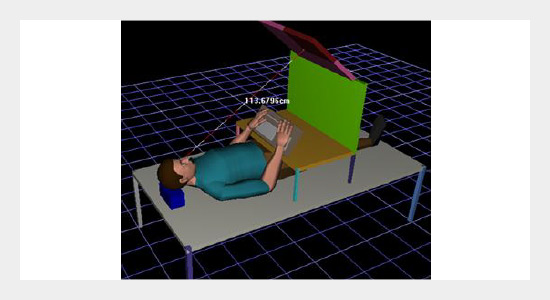Hsin-Chieh Wua*, Hao-Long Honga, and Yu-Cheng Linb aDepartment of Industrial Engineering and Management, Chaoyang University of Technology, Taiwan, R.O.C.
bDepartment of Computer-aided Industrial Design, Overseas Chinese University, Taichung, Taiwan, R.O.C.
Download Citation:
|
Download PDF
Seated posture has been considered as potentially one of the major contributing factors for several musculoskeletal disorders such as lower back pain, neck and shoulder disorders. Especially, people with low back pain experience great discomfort related to computer operations in sitting position. When changing posture to lying down, not only can release psychological stress, but also alleviate musculoskeletal burdens. Therefore, the main purpose of this study is to design a new supine computer workstation, allowing people to lie in the bed and operate a computer. This paper presents how to apply computer-aided ergonomic simulation in designing a new supine computer workstation. At first, Taiwanese anthropometric data were referred to build a 3D model of a supine computer workstation. And then, JACK software was used to simulate human-workstation interaction in order to find the problems of the original design. Finally, a physical prototype of the revised supine computer workstation was made for realistic test. The developed supine computer workstation was confirmed to be used successfully for operating computer in lying position. More field studies are required to test if supine computer workstation outpaces the sitting position workstation for musculoskeletal strains, subjective comfort, and operation performance.ABSTRACT
Keywords:
Office ergonomics; computer simulation; work posture; workstation; design
Share this article with your colleagues
[1] Wu, H.C., Lin, C.Y., Chen, H.C., and Wang, C.H. 2007. Relations between ergonomic risk factors and musculoskeletal disorders in computer operation. Journal of Ergonomic Study 9:1-10(in Chinese).REFERENCES
[2] Wu, H.C. and Chen, T. 2006. The development of an electronic tool for diagnosing risk factors in computer operation. WSEAS Transactions on Computers 5:1013-1019.
[3] Andersson, B.J.G. and Ortengren, R. 1974. Lumbar disc pressure and myoelectric back muscle activity during sitting. 1. Studies on an office chair. Scandinavian Journal of Rehabilitation Medicine 3:115-121.
[4] Keegan, J.J. 1953. Alterations of lumbar curve related to posture and seating. Journal of bone and joint Surgery 35:567-589.
[5] Yamaguchi, Y., Umezawa, F., and Jshinada, Y. 1972. Sitting posture: an electromyographic study on healthy and nostalgic people. Journal of the Japanese orthopedics Association 46:51-56.
[6] Cartas, O., Nordin, M., Frankel, V., Malgady, R., and Sheikhzadeh, A. 1993. Quantification of trunk muscle performance in standing, semistanding and sitting postures in healthy men. Spine 18:602-609.
[7] Ebe, K., and Griffin, M.J. 2001. Factors affecting static seat cushion comfort. Ergonomics 44 10: 901-921.
[8] Lengsfeld, M., Frank, A., van Deursen, D.L., and Griss, P. 2000. Lumbar spine curvature during office chair sitting. Medical Engineering & Physics 22:665-669.
[9] Videman, T., Nurminen, M., and Troup, J. 1990. Lumbar spinal pathology in cadaveric material in relation to history of back pain. Spine 15:728-740
[10] Nachemson, A. and Elfstrom, G. 1970. Intravital dynamic pressure measurements in lumbar discs. Scandinavian Journal of Rehabilitation Medicine, Suppl. 1.
[11] Haynes, S. and Williams, K. 2007. Product review of alternative computer workstations as possible workplace accommodations for people with chronic low back pain. Technology and Disability 19:41-52.
[12] Wang, M.J., Wang, M.Y., and Lin, Y.C. 2002. “Handbook of Taiwanese anthropometric database”, Ergonomics Society of Taiwan, HsinChu, Taiwan.
[13] Jaschinski, W., Heuer, H., and Kylian, H. 1998 The preferred position of visual displays relative to the eyes: a field study of visual strain and individual differences. Ergonomics 41:1034-1049.
[14] Wu, H.C. and Chang, F.C. 2011. Ergonomic evaluation of computer desks and chairs for children — based on computer simulation. Journal of Ergonomic Study 13:41-51 (in Chinese).
ARTICLE INFORMATION
Received:
2014-11-18
Revised:
2015-03-10
Accepted:
2015-03-17
Available Online:
2015-06-01
Wu, H.C., Hong, H.L., Lin, Y.C. 2015. Application of Computer-aided ergonomic simulation in designing supine computer workstation. International Journal of Applied Science and Engineering, 13, 163–169. https://doi.org/10.6703/IJASE.2015.13(2).163
Cite this article:






